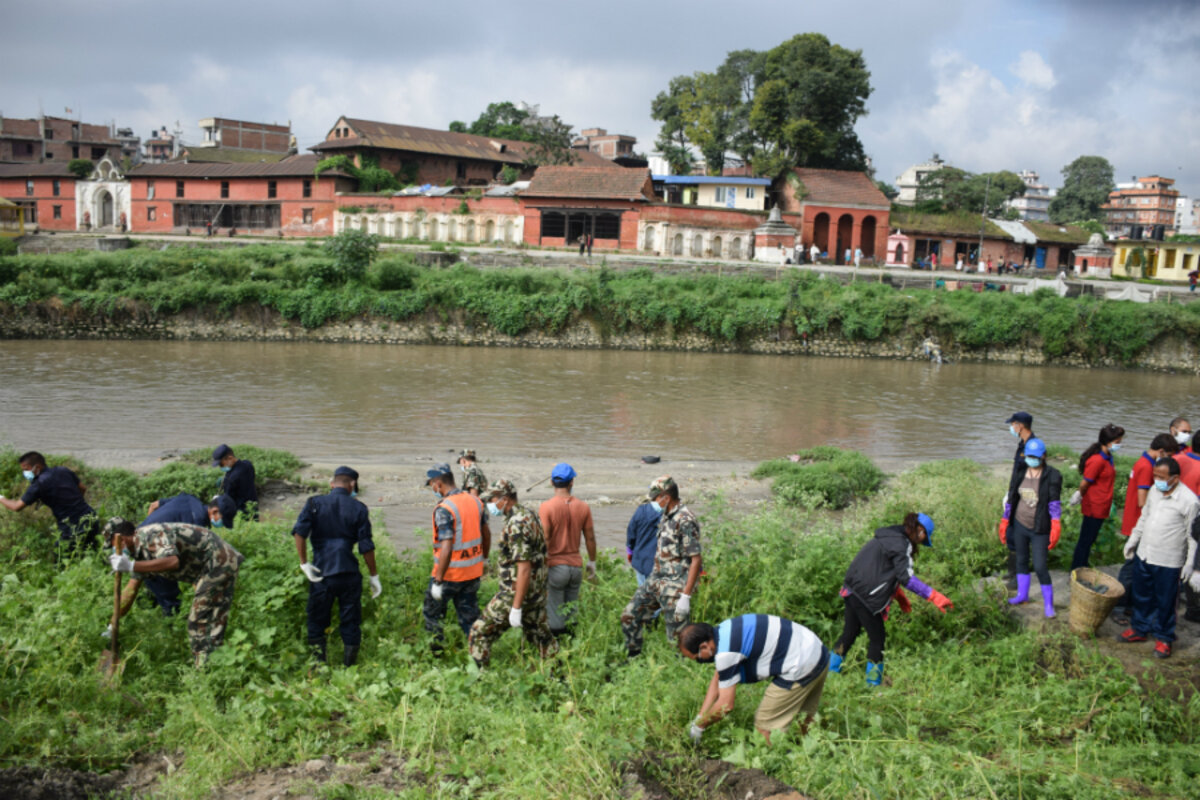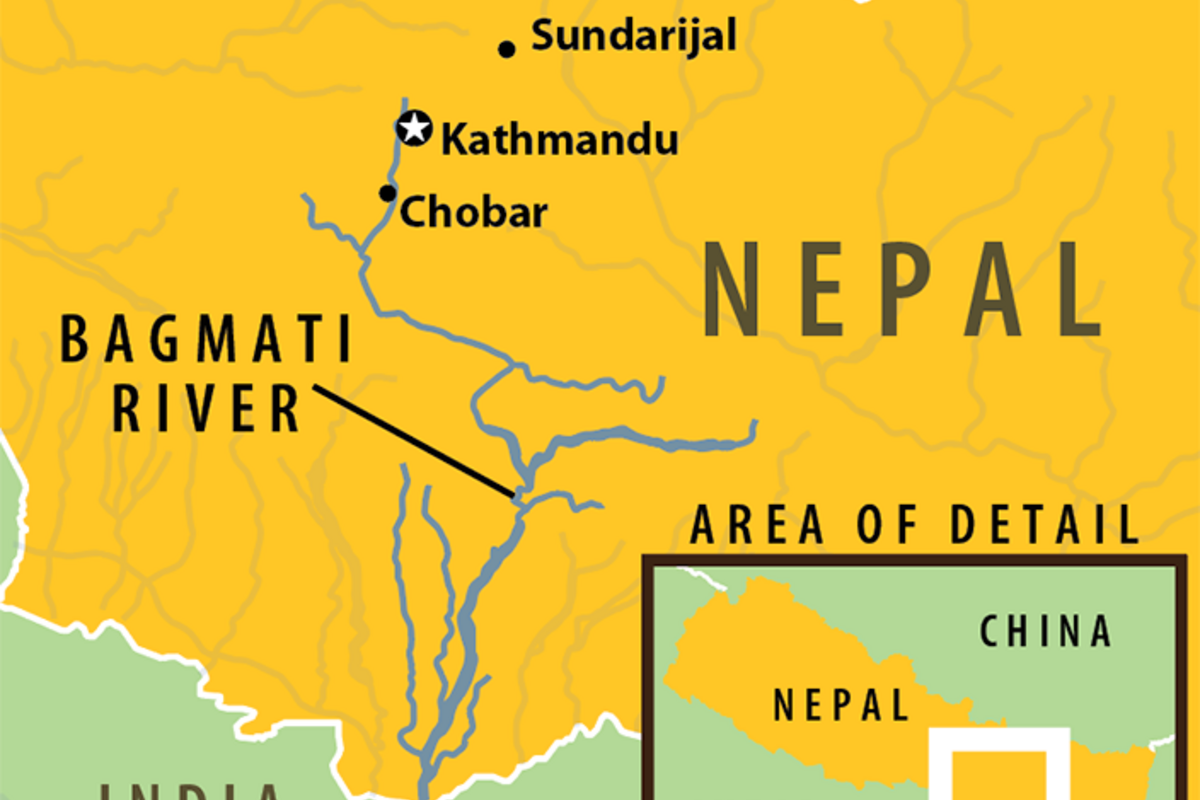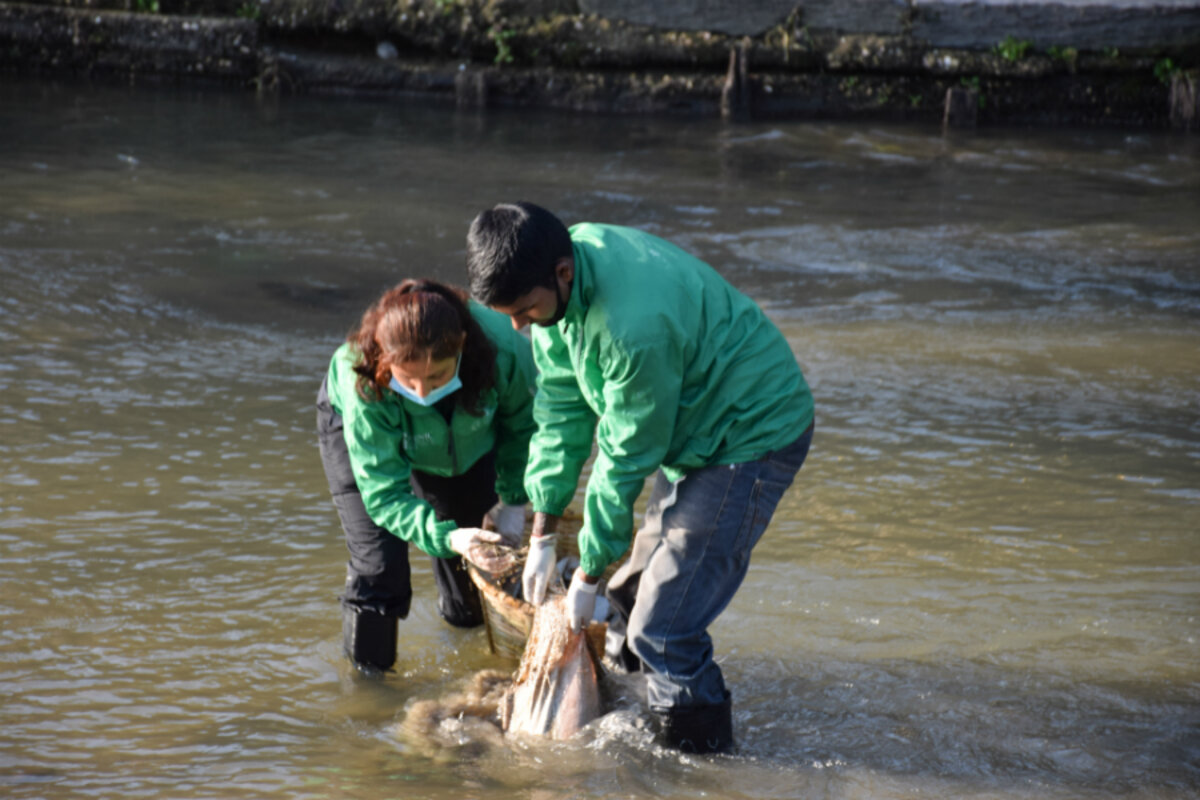In Nepal, 'appalling' river runs cleaner in wake of unusual partnership
Loading...
| Kathmandu, Nepal
On an April morning last year, more than 100,000 people congregated on the banks of the Bagmati, the largest river flowing through this city.
As news helicopters whirred overhead, people lined up along the length of the river on either side and linked arms from Sundarijal, in the hills north of Kathmandu, to Chobhar, at its southern tip, forming a “human chain” 17 miles long.
��“The message was: we will not let you litter in the river,” says Ram Sah, a volunteer at Bagmati Safai Abhiyaan, the movement that organized the event to mark its 100th week of work.
Campaigns to clean the river – which once featured in a TV show called “Bijok Bagmati,” or “Appalling Bagmati” – crop up here every few years, full of airy promises, only to quickly fizzle out. But the Safai Abhiyaan, now past its 180th week, attracts hundreds of people who are willing to wade knee-deep into turbid water every Saturday to fish out trash.
The range of its volunteers –��from local celebrities and police and Army officers to senior bureaucrats and politicians – has lured in people like Mr. Sah, an activist and the movement’s unofficial secretary.
“I thought, ‘If they’re willing to do this, it's my responsibility to help,’” he says.
��
In Nepal, where public demands get short shrift and whispers of corruption stalk anything government-affiliated, the movement is an unusual partnership between the two. Guided by the public and backed up by police and government agencies, it’s been able to take on politically charged issues too volatile to handle otherwise.
While this arrangement has its detractors, Sah points to outcomes: In three years, some 7,000 metric tons of garbage – an estimated 80 percent of the river’s solid waste – has been dredged from its waters and extracted from its banks. Testing shows levels of organic and inorganic pollution have declined throughout, in some stretches by as much as three to five times. Upstream, where the water is clearer, people are fishing again for the first time in decades.
For residents like Deuman Sherma, a squatter who’s occupied a riverfront shanty in Kathmandu’s Sinamangal neighborhood for 15 years, the effects are hard to overstate. A steady trail of garbage – tangled masses of jute and plastic – floated past his house just a few years ago. More distressingly, the river used to emit a powerful stench that enveloped his entire neighborhood, growing more putrid in the winter.
“Before, when we had anyone over – guests – it was mortifying,” he says. “It doesn’t smell at all now.”
��'We'll do it'
In early 2013, Leela Mani Paudyal, then chief secretary and the highest-ranking bureaucrat in the Nepali government, was approached by members of the Gayatri Pariwar, an activist spiritual group based in India. The Pariwar’s Nepal branch had invited 500 Indian members to clean the Bagmati, which drains into the Ganges river in India and is sacred to Hindus, and was seeking government assistance.
��Mr. Paudyal refused – but not for lack of interest. “I told them, ‘We polluted the Bagmati, and we're bringing people from India to clean it up? I can't accept that,’” he says. “I said we would clean the mess we made ourselves.”
Leveraging his position in the government, Paudyal, widely considered the movement’s leader, brought state and security agencies on board. He arranged weekly meetings in his office, where volunteers gathered to demand progress reports from agency representatives.
Initially, there was skepticism about yet another Bagmati campaign.
“People called us frogs,” Kishore Shahi, an early organizer, says chuckling. “They said we would jump around frantically for a few weeks and then leave. Later, when they saw how regular we were, going every Saturday, they said we must be gobbling up NGO dollars.”
Over the next year, however, the movement began drawing thousands each week, a turnout Paudyal chalks up partly to good showmanship –��when testing established that the water in the Guhyeshwari had become fit for washing, for example, he held a mass public bathing session there.
��
Paudyal and others have been careful to protect the image of the movement as volunteer-driven. Decisions are still made in the open, by consensus. For the sake of transparency, volunteers declined to register the movement as an organization and have banned fundraising in its name. And they’ve kept it apolitical, shutting out what Paudyal calls the “corrupting influence” of Nepali politics.
This approach has proved useful as the movement has started handing over sections of the river to local communities to manage in order to tackle thornier issues, such as encroachment, littering and sewage, where they butt up against vested, often political, interests.
Despite its results, the movement has aroused concern in some who take issue with how it operates. “It’s not a volunteer movement at all,” says Hari Sharma, a social scientist. “It works because of the police.” He pauses. “But maybe that’s the only way you can get things done in Nepal.”
Volunteers argue they only needle authorities into doing what they should have been doing all along:��enforcing regulations. But to some under their glare, police backing feels like a way to enable unconventional tactics.
Clashes
On a recent Saturday, Rewoti Panta, a resident of an apartment block facing the river, was participating in the cleanup when he saw a brawl erupting outside his building. A crew of volunteers, fingers stabbing at a land deed, was trying to shut down a road leading out of the building, alleging it encroached on government property. Under their ambitious “beautification” plans, the riverfront was to be re-treed; the construction of a “yoga park” was in the planning stages.
Protesting the sudden offensive, apartment residents parked themselves on the bulldozer. A shouting match broke out. As police looked on, volunteers grabbed nearby rocks and within minutes had cemented together a crude wall to seal off the road.
“Everyone is a big shot when the police is behind them,” Mr. Panta exclaimed afterward as volunteers emptied from the site. “What can we do against that kind of force?”
But Mr. Shahi claims most people are grateful after they experience the benefits of a cleaner river.��He stresses the movement’s role in diverting sewage –��the biggest pollutant – from the water, something Rajesh Singh, project manager in the government office that monitors the Bagmati, declares is its biggest victory.
Inside the Kathmandu valley, sewer lines run alongside the Bagmati for 12 of its 17 miles, breaking off in squatter settlements, rows of brick-and-concrete shanties that slope downward on the riverbank, blocking the path a sewer line would take. In the Sinamangal neighborhood, squatters had rebuffed government attempts to install lines for two years.
“When government officials went to survey the area, the residents beat them up,” says Shahi. “But we told them we weren’t coming to uproot anyone, only to help.”
Shahi says squatters were willing to negotiate and make concessions after it became apparent their interlocutors were not government agents. But even here force played a hand –��Paudyal warned squatters he would return with bulldozers if they didn’t pull down the offending houses.
Eventually they gave in, allowing 2 miles of mains to be laid down. Despite his initial misgivings about the project, Mr. Sherma, a resident, says he’s thankful for it whenever he passes by Thapathali, a downstream spot where squatters have not yet relinquished land and the water is still murky and rank.
“It helps us all to be saved from the Bagmati’s pollution,” Sherma says, noting the threat of disease the sewage had posed. “I worried about our health and my kids’ health. I feel like a weight has been lifted from my heart.”
Spurred on by the visible change in the Bagmati, campaigns operating under similar models have sprung up in more than 20 cities and towns across Nepal. In Pokhara, a lakeside city 120 miles west of Kathmandu, more than 1,000 people turn up each week.��
The aim of these campaigns, Sah says, is to restore rivers to their state 30 years ago. That means removing trash, pushing back on encroachment and clearing the way for new sewer lines.
Yet Sah maintains that in some ways these are cosmetic measures: ensuring the river stays clean will require another kind of effort. “We can’t keep cleaning if people keep polluting,” he says, insisting the Bagmati campaign has its sights set higher.
“Something fundamental is wrong: we think of the river as a trash can,” Sah says. “That is what we have to change.”






